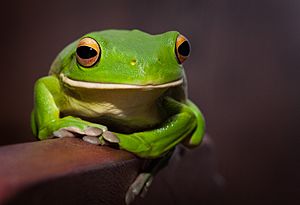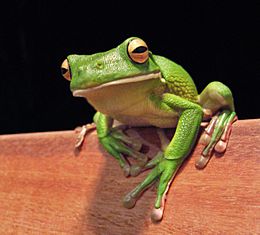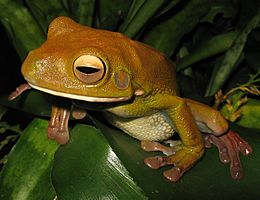Giant Tree Frog facts for kids
Quick facts for kids White-lipped Tree Frog |
|
|---|---|
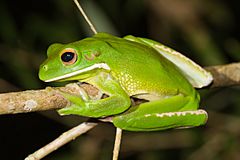 |
|
| Conservation status | |
| Scientific classification | |
| Kingdom: | |
| Phylum: | |
| Class: | |
| Order: | |
| Family: | |
| Genus: | |
| Species: |
L. infrafrenata
|
| Binomial name | |
| Litoria infrafrenata Günther, 1867
|
|
The White-lipped Tree Frog (Litoria infrafrenata) is also known as the Giant Tree Frog. It is a type of tree frog and is the largest tree frog in the world! These amazing frogs live in Northern Queensland, New Guinea, the Bismarck Islands, and the Admiralty Islands.
Giant Tree Frogs are related to the White's Tree Frog. They mostly eat insects and other small creatures called arthropods. In the wild, they can live for up to 10 years. In Australia, people can keep them as pets, but they need a special license to do so.
Contents
What Does the White-lipped Tree Frog Look Like?
The White-lipped Tree Frog can grow to be about 11 to 14 centimeters (4 to 5.5 inches) long. Female frogs are usually bigger than males.
Most of the time, their back (called the dorsal side) is a bright green color. But their color can change! It depends on the temperature and what they are sitting on. Sometimes, they can even turn brown. Their belly (called the ventral side) is usually an off-white color.
A cool thing about these frogs is the clear white stripe on their lower lip. This stripe is why they are called "White-lipped"! It goes all the way to their shoulder. When male frogs are ready to breed, the white stripes on their lower legs might turn pink.
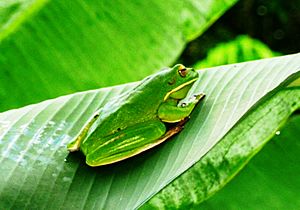
White-lipped Tree Frogs have big toe pads. These pads help them climb trees easily. Their toes are fully webbed, which means they have skin between them. Their hands are partly webbed too.
Where Do White-lipped Tree Frogs Live?
The White-lipped Tree Frog lives in Australia along the coast of the Cape York Peninsula and in the wet, tropical areas of north-eastern Queensland. It is also found across a large part of the New Guinea region. This includes eastern Indonesia, the main island of New Guinea, and the Bismarck and Admiralty Islands in the north.
These frogs like to live in rainforests, farm areas, and even near houses in coastal places. They usually live in areas that are not higher than 1200 meters (about 3,900 feet) above sea level.
How Do White-lipped Tree Frogs Behave?
The White-lipped Tree Frog has a very loud, barking call. But if it gets scared, it might make a sound like a cat meowing. It can also release urine if it feels threatened.
Male frogs make their calls during spring and summer, especially after it rains. They usually call from plants near still water, which is where they like to breed.
Their main food is insects and other arthropods. These frogs can live for more than 10 years in the wild.
Keeping White-lipped Tree Frogs as Pets
People sometimes keep White-lipped Tree Frogs as pets. However, in Australia, you need a special permit or license to own one. This helps make sure these frogs are cared for properly.
Images for kids
See also
 In Spanish: Rana arborícola de labio blanco para niños
In Spanish: Rana arborícola de labio blanco para niños



